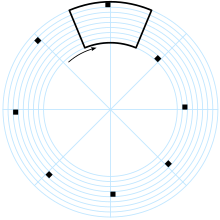
A Nipkow disk (sometimes Anglicized as Nipkov disk; patented in 1884), also known as scanning disk, is a mechanical, rotating, geometrically operating image scanning device, patented in 1885 by Paul Gottlieb Nipkow. This scanning disk was a fundamental component in mechanical television, and thus the first televisions, through the 1920s and 1930s.
== Operation ==
The device is a mechanically spinning disk of any suitable material (metal, plastic, cardboard, etc.), with a series of equally-distanced circular holes of equal diameter drilled in it. The holes may also be square for greater precision...